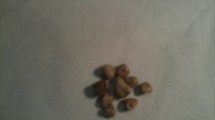Summary
A method is described for the growth of calcium oxalate dihydrate in normal urine. Soluble chlorophyllin, at a concentration of 20 μg/ml inhibited the crystallisation and the growth kinetics of the dihydrate crystals. The inhibitory capacity of chlorophyllin was compared with previous results. Data obtained suggest that the food and drug colourant chlorophyllin might be useful in the treatment of calcium oxalate stone disease.
Similar content being viewed by others
References
Berg W, Schnapp JD, Schneider HJ, Hesse A, Hienzsch, E (1976) Crystaloptical and spectroscopical findings with calcium oxalate crystals in urine sediments. A contribution to the genesis of oxalate stones. Eur Urol 2:92
Berg W, Hesse A, Schneider HJ (1976) A contribution to the formation of calcium oxalate urinary calculi III. On the role of magnesium in the formation of oxalate calculi. Urol Res 4:161
Hienzsch E, Hesse A, Berg W, Roth J (1979) A contribution to the formation mechanism of calcium oxalate urinary calculi IV. Experimental investigation of the intrarenal crystallization of calcium oxalate in rabbit. Urol Res 7:223
Tawashi R, Cousineau M, Sharkawi M (1980) Calcium oxalate formation in the kidneys of rats injected with 4 hydroxy-L-proline. Urol Res 8:121
Desjardins A, Tawashi R (1978) Growth retardation of calcium oxalate by sodium copper chlorophyllin. Eur Urol 4:294
Bisaillon S, Tawashi R (1976) Retardation of growth and dissolution of calcium oxalate monohydrate. J Pharm Sci 65:222
Tawashi R, Cousineau M, Sharkawi M (1980) Effect of sodium copper chlorophyllin on the formation of calcium oxalate crystals in rat kidneys. Invest Urol 18:90
Harrison JWE, Levin SE, Travin B (1954) The safety and fate of potassium copper chlorophyllin and other copper compounds. J Am Pharm Assoc Sci Ed 43:722
Martindale (1977) The extra pharmacopocia. In: Wade A, Reynold JEF (eds) The Pharmaceutical Press, Londen, 27th ed
Werness PG, Duckworth SC, Smith LH (1979) Calcium oxalate dihydrate crystal growth. Invest Urol 17:230
Gardner GL, Doremus RH (1978) Crystal growth inhibitors in human urine effect of calcium oxalate kinetics. Invest Urol 15:478
Tawashi R, Cousineau M (1980) Growth retardation of weddellite by sodium copper chlorophyllin. Invest Urol 18:86
Ismail SI, Tawashi R (1980) Size distribution characteristics of mineral phase in renal stones. J Pharm Sci 69:830
Markovic M, Komunjer L (1979) A new method to follow crystal growth by Coulter Counter. J Cryst Growth 46:701
Tomazic B, Nancollas GH (1980) Crystal growth of calcium hydrates: a comparative kinetics study. J Colloid Interface Sci 75:149
Author information
Authors and Affiliations
Rights and permissions
About this article
Cite this article
Tawashi, R., Cousineau, M. & Denis, G. Crystallisation of calcium oxalate dihydrate in normal urine in presence of sodium copper chlorophyllin. Urol. Res. 10, 173–176 (1982). https://doi.org/10.1007/BF00255940
Accepted:
Issue Date:
DOI: https://doi.org/10.1007/BF00255940




